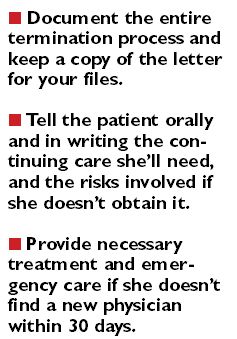Article
Malpractice Consult
If a patient refuses to be fired

A No physician should have to endure unreasonable abuse from a patient to himself or his staff. The doctor-patient relationship is supposed to be voluntary for both parties-meaning that each has the right to terminate it at any time.
For the doctor, however, the re-quirements for ending the relationship are more complicated than for the patient, because you have to avoid a claim for abandonment. You've made the right moves so far with your certified letter, but this patient obviously knows the rules of the game, and is trying to beat you at it.
Tell the patient orally and in writing the exact nature of her condition, the continuing care she'll need, and the risks involved if she doesn't obtain it. Document that advice in her chart. Every patient has the right to refuse recommended treatment, but she must do so with full knowledge and understanding of potential adverse outcomes.
Also provide her with a list of other cardiologists in the area, including their addresses and phone numbers. Then ask her to sign an authorization to transfer her records to whomever she chooses as her new physician. If she refuses, document that as well.
You may have difficulty following this plan of action if the patient is enrolled in a managed care plan and your contract doesn't permit you to discharge a plan member on your own authority. But it's still not impossible. Call the plan's medical director, describe the patient's disruptive behavior, and ask for permission to dismiss her. You should also ask for assistance in finding her another cardiologist in the plan. Document those conversations and requests as well. Then proceed with the steps outlined above.
Remember that you're still obligated to provide this patient with emergency care during the 30-day transition period if she doesn't find a new physician within that time. In case she comes to the office during that period and continues her abusive behavior, tell your staff to document it. Help them develop a game plan for dealing with her, and let them know the end is in sight.
____________________________________________________________
The author, who can be contacted at 4 Carlton Drive, Mount Kisco, NY 10549 or atlj@bestweb.net , is a healthcare attorney specializing in risk management issues.
This department answers common professional-liability questions. It isn’t intended to provide specific legal advice. If you have a question, please submit it to Malpractice Consult, Medical Economics, 5 Paragon Drive, Montvale, NJ 07645-1742. You may also fax your question to 973-847-5390 or send it via e-mail to memalp@advanstar.com .





